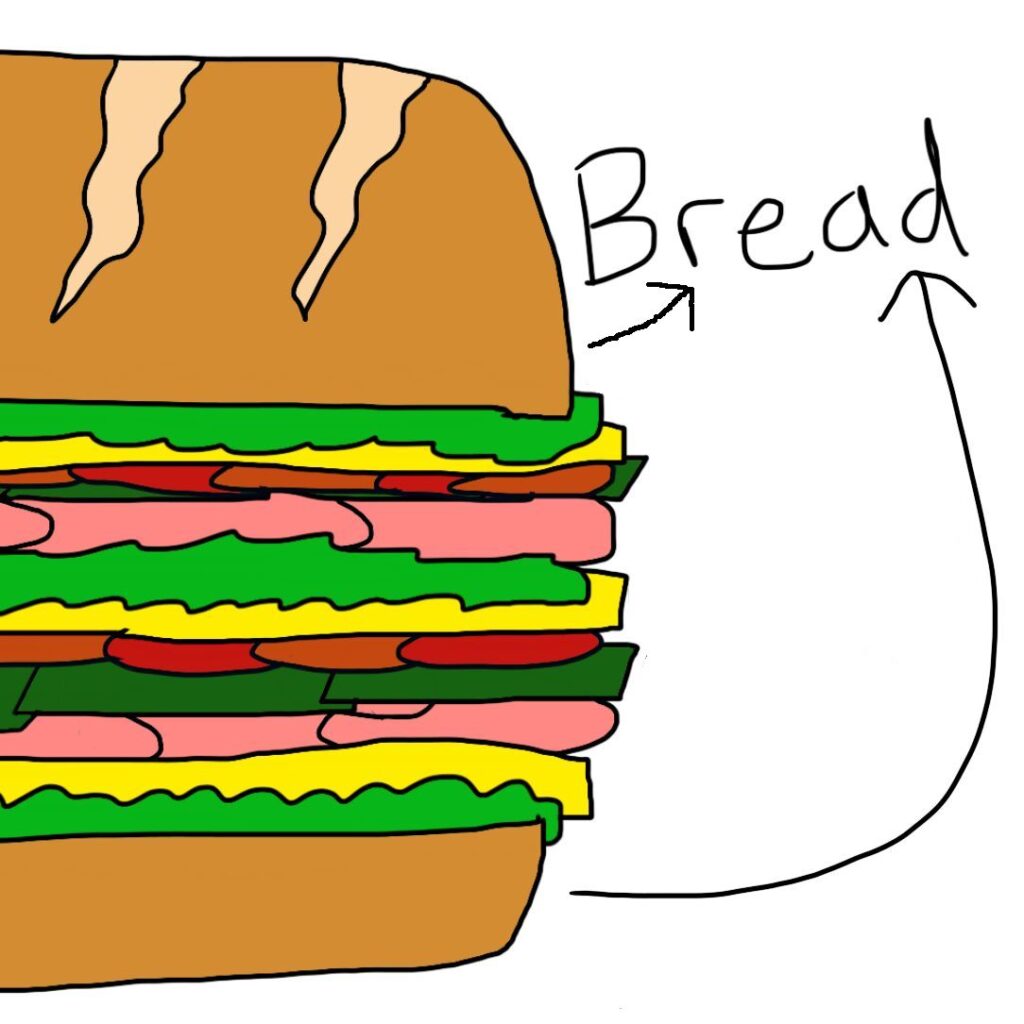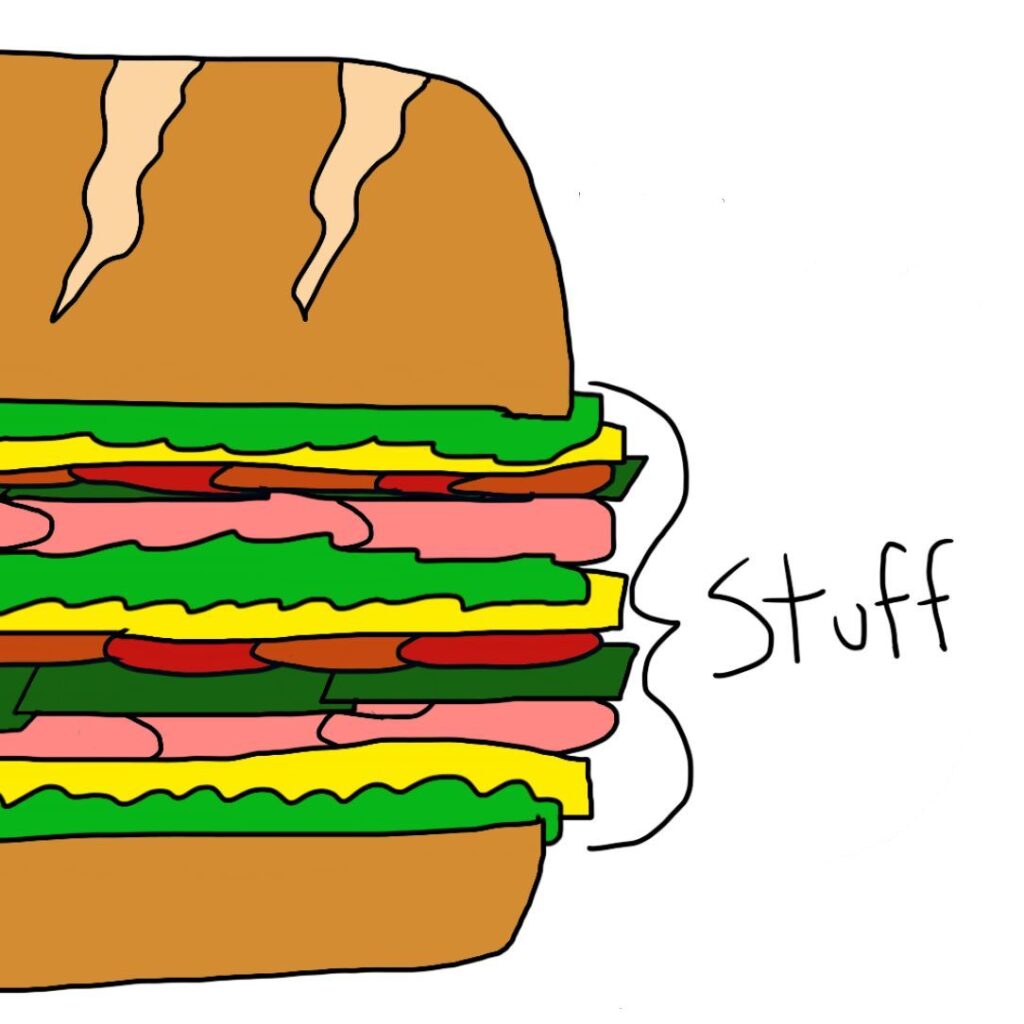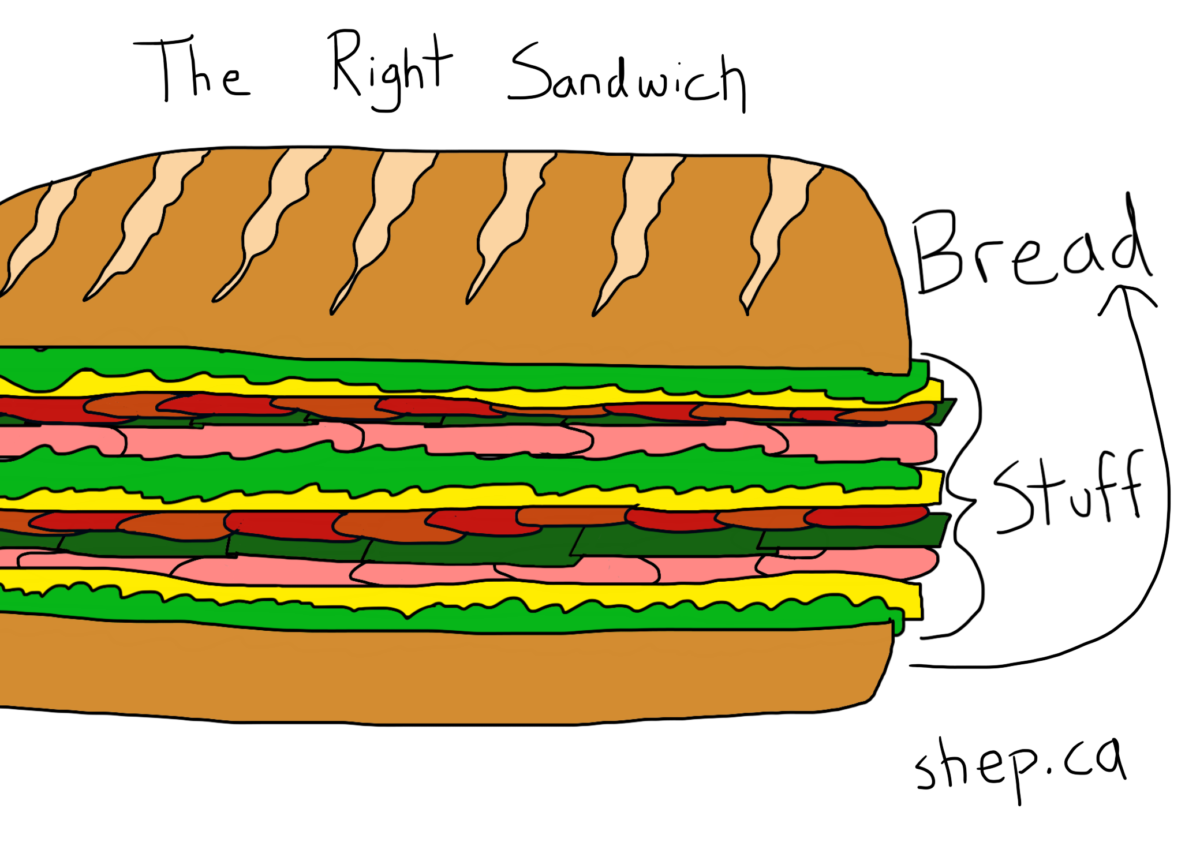I’ve spent the last month thinking about internal communications a lot…
- Part One: Why Higher Ed is So Bad At This
- Part Two: Internal/External Comms Conflation
- Part Three: Making the Case for Internal Comms
…starting with the problem as I see it, poking at how putting internal messages on external challenges isn’t a great solution, making a case for how it adds value across the board, and here we are at the “how”.
I don’t think there is a single “how.” Saying there’s a right way to do it is like saying there’s only one kind of sandwich. There are all kinds of sandwiches for different times and different purposes, from crust-off PB&J to triangle-cut church-basement egg salad to six-foot party hoagies.

I like sandwiches as a metaphor: they’re a delivery system for content, but the method of conveyance is also vital. The bread is part of the package and part of the experience. Jamming tuna salad into a wrap is very different than putting it in between two slices of toasted rye; in the same way, a photo essay on Instagram is a different experience than the same set of photos in an email. The sandwich is the message! It’s Marshall McLuhan, but tasty.
I’ve gotten a lot of interesting and useful feedback since I started this; email, messages from colleagues on various platforms, LinkedIn comments — and it’s clear that there’s an appetite for this, and a general understanding of the value and need. Interesting questions like “are students an ‘internal’ audience in higher ed, or ‘clients’?” Also a lot of compassion for the people who need to be communicated with — students, staff, faculty.
As somebody who wants to spend time in this space, figuring it out at the faculty (academic unit, not professors) level and in a way that coheres with both broader (university) and narrower (department/school) plans, I’ve been using the last month to try to get some principles to cohere. These are truths for me, and not universal ideas.
For reasons detailed below, I wind up leaning in a certain direction for channel, format and content… but my answer may not be your answer.
I’m also focusing on students — the largest audience, and also the one with the widest array of frequently conflicting needs. But I think it all adapts/scales to other audiences as well.
Every single thing below is contentious. If I’d been smarter about this, I could have gotten months of content by breaking out each item in a bit more detail for a zillion short entries instead of this marathon.
Sidebar: It’s hard to know what’s true about Generation Z audiences.
The fun thing about investigating marketing is that the people who tell you what channels to use are usually marketers. So I can easily find data that proves Gen Z is gaga for email… from a company that provides email marketing services. Gen Z mainly just watches videos… says a company that captions videos. And so on.
The bread: what conveys your content?

It can’t be social media.
This is pretty obvious for me — social media can enhance a communications strategy, but it can’t be the communications strategy for internal audiences. First, there are equity issues: you can’t force a student to be part of a third-party, for-profit system with privacy and security practices you don’t control. It’s a minefield ethically, and from a security/privacy standpoint. Second, there’s that internal/external divide again. Can you set up channels specifically for internal audiences on social? Sure! It’s done often, and effectively: there’s no reason the campus’ physical plant team can’t set up a Twitter account to broadcast where they’re at with ploughing after heavy snowfalls, or the wellness team can’t try to spread positivity on Instagram. But outside of narrowcasting, I have a hard time seeing myself counseling, say, our faculty setting up a parallel set of social feeds for our internal audiences without the chance of mass confusion with our external channels.
Also: social media is work. It can look fun, and tends to get discounted as a zero-work bolt-on in plans, but it takes time and care to write content and craft graphics — to increasingly distinctive specs — for the four or five “must-have” channels to bat the circuit.
Being in-flow is the challenge…
Social media has a lot of momentum on its side. It’s where people are already, and it’s much easier to push something into somebody’s flow where they are than to try to pull them into taking an action they normally wouldn’t. Our student society is hugely successful at reaching our current students on social — far more than the faculty’s social channels — because they have a single, clear, isolate purpose for social media: to communicate with current students. So not being on social feels like we’re missing a step, and not fishing where the fish are.
…but being on social doesn’t mean being in-flow.
That said, social media presence doesn’t ensure social media attention. Just cutting and pasting a paragraph and tossing it into Insta with a stock photo of a duck won’t get you seen / liked / etc. And, see above, social media is work. And not just one-off effort. If you’re not maintaining a constant presence with high engagement, the key channels will disfavour you algorithmically, putting you into a “death spiral” where you’re being delivered to fewer people, which means less chance of engagement, which means you get delivered to even fewer people…
I’m not saying social media as part of an internal comms strategy is a bad idea — but it’s not a light idea, and it can’t (for equity reasons) be your sole method. You can lean in and do it well, consistently, and with commitment, committing a lot of capacity and effort. But it’s a serious investment, for specific services. I don’t think it’s a mass-comms tool.
I like apps, but not as a sole delivery vehicle.
Our faculty has a great bespoke app for our students. I really like it — and I’ve invested time and effort in driving attention and use. I’m all in on making it work — but it’s been a challenge, to date, to get the kind of mass adoption we’d like to see in the faculty.
This is partly a flow issue — the app is, at the end of the day, an out-of-flow push proposition. We’re asking students to open an app of their own volition, in competition with everything else they could be doing on their phone in that moment.
Its killer function is — for me — the fact that it ties into our learning platform, so once you’re logged in, the home screen shows your class schedule and assignments for the day. This is where I think we could reach flow with our students — it’s more intuitive and navigable than the mobile view of the learning software’s web presence. So there’s a possible future where it becomes the natural place for our students to go periodically through the day to check in — and while they’re there, see announcements, chat in various discussion groups, and use other offerings like the ability to communicate directly with course advisors, the student services team, etc.
While we’ve put some time and effort into it, I think it will take a concerted commitment of money/capacity/brainpower to really surge use, and push us past that 50% critical mass of students where we can truly see a step change in adoption and use. It’s not capacity we have at the moment — but the summer is coming.
The above all applies to “portal” sites as well — essentially, offering the same consolidation service as an app, but over time training people to skip directly to the content they need instead of truly engaging with the collateral you’re scattering on other places on the page.
There’s also an equity issue I have some issues with here: not all students have modern phones, and not all students will have top-notch service with loads of data to play with.
Ultimately, I think it’s email.
I know, I know. Boo! Email! Nobody likes email. Very few people wake up in the morning aching to check the email. But… everybody checks their email anyway. It’s the closest thing to a dependable in-flow tool that we have; it’s effectively mandatory, completely controllable, and segments amazingly.
It also doesn’t have to be a slog. If you commit to it, you can create email content that’s essential, enjoyable and compelling. That’s — again — work. But it’s not out of the question.
And I think it’s newsletters.
Boo again! But having lived in newsletter systems and non-newsletter systems, I think your odds of being read are about equal either way, and newsletters have the following benefits:
- It makes content wrangling systemizable: the person running this system can set up processes for sending content in, and managing content on deadlines.
- It removes the Darwinian aspect of more attention going to the better e-mail senders
- It institutes flow control and diminishes overall email volume
- It can provide a consistency and reliability in format and expectations
- If it is your ‘essential’ channel, readership will stabilize over time
- You can create and manage expectations around newsletters. “You will get one of these a week and you’re expected to read it” is a simple message, and easier to absorb/digest than “we’re going to be sending dozens of emails a week on various subjects at various times, and also posting in other places, so watch out.”
But I never read newsletters!
“_____ sends newsletters, and I never read them” does come up a lot. I hear that. I am also a newsletter-deleter. But I am also a newsletter reader, when I know that the newsletter contains information that’s pertinent, time-sensitive, and appealing.
I also think it’s online.
Note that I’m saying online, not web. I’m a quiet advocate of getting inside-baseball material off websites and onto well maintained internal systems (unless there’s a clear external marketing purpose to the material, but even then, I’d argue for adapting rather than repeating…).
- Essential dates and deadlines
- Policies, processes, and forms
- Archives of prior newsletters
- Ultimately, most of your stuff (see “Content/COPE” below)
I’m a big fan of portal-type pages: put things where it makes sense, then have a consolidated index where things are organized and graphically easy to find and get to. A topic for another time.
Event calendars are hard to build and hard to evaluate.
They feel essential in theory. There’s so much to organize it’s so hard to get a view of everything in one place! Surely a calendar…
But a good calendar is a bearcat. You need something that allows multiple parties to enter information, categorization, a way of managing multi-day events as well as short-duration events, and ideally a way of exporting feeds that can repopulate specific calendars in specific places (see “Content/COPE” below, again).
And then you have to get people to use it. Or not? I’d argue that a contemporary calendar is more of a repository than a destination. It’s a place to put your events, but trying to get people to spontaneously drop by an events calendar on a regular basis isn’t going to get a lot of traction.
Again, a topic that deserves more time, in time.
The Stuff: what goes in the bread?

This is a needs-based exercise, not a branding exercise
We’re squarely in the communications camp here. I think this is an area where brand and values can sing, but as a background context that drips — it’s ultimately about serving an audience. Start with them: poll/focus group your students and ask them what they need. Keep an open line with your boots-on-the-ground, student-facing staff: where are the current points of confusion and stresses? What can you help with now?
Ask the people what they want is a good start, beginning with your target audience but also the people they serve most often. If somebody is getting a dozen calls a week asking them to explain ____, this is a good sign that some communication needs to happen on that point.
Brand infuses all of this, but doesn’t outshine it. Graphics, text, all of it can lean into an overall harmony of message and conveying in institutional mission and purpose (and should), but the information comes first, and the infusion afterwards.
You need a permanent home base for vital content.
Email is where I lean as a vehicle, but email is also ephemeral. The vital information needs a home online: bookmarkable, 24/7 references to key dates and deadlines, administrative policies, etc. But also for your past emails — even just exporting to PDF and maintaining an archive list — and…well, everything, as we get into below. Portals, and finding not-your-main-website places to store information, is a long-term must.
Nobody sees anything that isn’t meant for them.
If there’s one cardinal rule in all of this: don’t waste people’s time and attention. That’s one of the reasons I’m fond of email — it segments beautifully. You can send email to all students, or just upper-years, or all staff, or only faculty, or just early-career faculty… if you’re willing to put the time in, you can create a dizzying array of segments to make sure the essentials are being shared.
Theory again collides with work here — these lists have to be conceived, created, and also maintained. This is effort, and while it’s easy to envision a coat-of-a-thousand-colours approach where you have newsletters for every segment imaginable, the practical component of making and maintaining those lists — to say nothing of curating the content for each — is nothing to sneeze at. And updating it is a double bearcat.
There’s a sweet spot where things are targetable without being too burdensome to maintain, though. The more people feel like you’re delivering material that matters to them, the more attention you’ll hold and retain.
Balancing the essential and the ephemeral
There’s a natural and eternal tension here; the age-old battle of the urgent vs. the important. Students should know when their application to graduate is due, but should that be a top item for two months leading up to the application due date?
Or should a late-developing talk happening tomorrow be the vital information, and the essential information have its own “key reminders” section further down?
There’s no easy answer here — see below — but my tendency is to put the fast-expiring items close to the top, and the long-term reminders further down.
Everyone’s stuff is important to them.
This is the toughest pill to ask people to swallow — nobody thinks their thing is unimportant, so asking them to put their thing into a pool with all the other things is galling. The corollary, though, is that everyone shouting at increasing volumes, constantly, is not tenable either. So organizing things into a set approach — stable, coherent — is the most community-minded way to go about this.
I think there’s a huge ancillary benefit here: de-siloing and contextualizing units that might normally be charging ahead with an exclusive focus on their KPIs.
COPE is dope.
Create once, publish everywhere. It’s a key philosophy in web design and management, and the central case for an email/web strategy: if content has an authoritative, editable home, it can be maintained in one place and reflected in others. This leads to the big content idea for newsletters…
Index and point…
On the COPE front: everything should have a home that isn’t an email. You don’t need all six points for a student to follow for their application to graduate — just that your application to graduate is due _____, and to follow the process here: ______.
This, for pretty much everything: events to an events calendar, funding and scholarship announcements to a list of them and their criteria, and so on.
…while being engaging and entertaining.
This seems like an impossible balance, until you bring framing into the picture. Not extravagant, elaborate mechanisms, but a lead-in graphic and paragraph. Peppering a few contests or swag giveaways throughout the thing. I ran a “Pets Of…” series, with student-submitted photos, in a prior newsletter for ages, with an amazing uptick in use.
You need a sandwich artist.
Jumping back a couple weeks, and a bit further up here: the work gets shortchanged and will always get shortchanged. “It’s just a newsletter” will be the default position of… well, everybody. The natural pull will be to put top talent on outward-facing things; the graphic designer and the writer and etc. will be back on the Viewbook and campaigns and this will just become somebody’s side-desk job. Fight this. It’s harder to make routine things interesting than it is to make… interesting things interesting.
Investing in something that sings, initially, will go a long way to helping encourage an institutional commitment to the resource. The people with the knowledge may not be the people best suited to craft the content in a compelling way (nor should they be expected to be! Different people are good at different things). Those resources need to be there, and reliably.
What do I need to know now > what must I know in general > other information
We get down to “what’s essential right now” pretty quickly. This is why processes should begin with the audience themselves and the front-line staff: they know what’s critical, where there’s urgency and confusion, and how to rectify it. What problem am I solving? is a good question for construction every week, or at whatever interval you’re releasing.
Remember that most people won’t see your pictures.
Most mail clients now do not load images by default, which means you can either come up with text that lives without visual support (recommended), or find slightly cheaty ways to try to encourage people to load the images (see the “Pets” idea above).
The ol’ retail switcheroo
Periodically, when I go into Peak Capitalism Paradise to buy a 40-lb. tub of mayo, I notice that stuff’s been moved. I’m forced to change aisles, look in different places for things, and break the mental conditioning that drives me to exactly the same spots every time I visit. This doesn’t turn me off to the point that I stop going — but it shakes me out of patterns and makes me notice things I haven’t noticed before.
So I’m intrigued by the idea of periodic format swaps — now events are at the top, but soon it’s key reminders, then student club notices — but not having tried it, I’m not sure what the result would be. It’s a way of breaking the “skim to X” pattern issue, though.
And we have only just begun to sandwich
Believe it or not, I think the above represents… maybe a quarter of what I have rattling around in my head about internal comms channels and content. But I’m clocking 1500+ words at this point, and I think the best I can do — preserving my own sanity, and at least part of my Sunday — is to park it here for now.
January 14 and January 21, 2021
Soundtrack:
Echo and the Bunnymen, “Echo and the Bunnymen”
F*ck Buttons, “Tarot Sport“
Blanck Mass, “Dumb Flesh“
Ex Hex, “Rips”
Various Artists, “Super Somali Sounds from the Gulf of Tadjoura”
The Hold Steady, “Separation Sunday“
